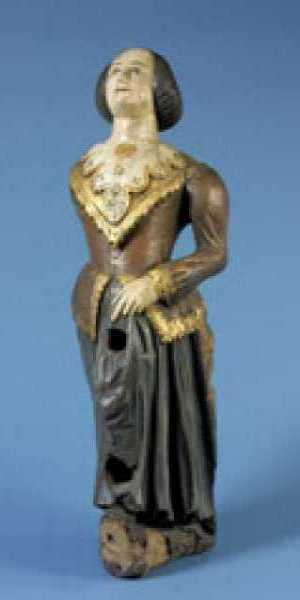I've seen the tinder starters before, and there are a lot of examples of the powder testers available on the net, but I can't find one real period example of that darn cannon firing flintlock anywhere.
George F. Harding evidently collected a lot of different things in his lifetime, these powder testers are also part of the Art Institute of Chicago's collection.
Belgian, Liege
Guillaume Berleur
Belgian, early 19th century
Flintlock Powder Tester, early 19th century
Steel, walnut
L. 31 cm (12 3/16 in.)
George F. Harding Collection, 1982.2326

Belgian (?)
Percussion Powder Tester, c. 1830
Walnut, brass, steel
L. 15.5 cm (6 in.)
George F. Harding Collection, 1982.2999

This is a slightly off topic, but you guys were talking about the 'Golden Age of Sailing' books that KABAR got, and as I said, Mr. Harding collected a lot of different items in his time. I had no idea that ships figureheads could be worth that kind of money. This article is from a website called "LiveAuctionTalk."
Women in Purple & Blue dress; from the Brig Martha; full-length figure; 1850-1860; 54 inches high; sold for $270,000. Photo courtesy of Northeast Auctions.

HARDING MUSEUM SHIPS' FIGUREHEADS SAIL AT NORTHEAST AUCTIONS
The ships lined up as far as the eye could see on the New York waterfront in the 19th century. The bows of these ships jutted out over the wharves showing off their massive rigging and their mind boggling display of figureheads.
Just about every merchant vessel displayed a carved and painted figure gazing outward. Lit from below by flickering reflections of waves, or mirrored in the water, these figureheads were the art work of the seafaring world.
Some call it idol worship, but the crew believed figureheads were endowed with magical powers which would keep them safe. Like Neptune’s hostages, any damage to them meant certain disaster at sea.
The ships these figureheads belonged to are long gone, but the wooden effigies remain behind like tombstones. Ever watchful of intruders, a typical American full-length, life-size figurehead leaned forward and was slightly detached from the bow.
American carvers used everyday life for inspiration. Wives and daughters of ship owners made good models as well as kings, generals, eagles, serpents, and even figures of Lady Liberty.
Smaller ships used busts, heads, and half and three-quarter-length figures with scroll and leaf carving. Figureheads, carved stern boards and billet heads were some of the only carving found on early sailing ships. The attention to detail in many of these carvings makes them real works of art. They’re highly collectible today.
As a tradition, figureheads extend as far back as ancient China and Egypt. If these wooden effigies could speak, what might they say about the storms they knew and the sailors they buried?
Figureheads, like the ships they came from, are perishable. Most of the wooden survivors date from the 19th century. This was the golden age, a time when carvers gilded and colored their sculpture.
Sometimes ship builders hired master carvers. Many of the best English examples were carved by local carvers working on small sailing vessels of 200 tons and under. They were often oblivious to artistic trends.
American early-20th century carvers like John Haley Bellamy were regarded as serious artists. Bellamy made his living carving ship eagles. He rarely signed his work but his eagles were so lifelike they stand apart from all others.
Bellamy’s most famous work, the Lancaster eagle figurehead, is on permanent display at the Mariner's Museum, Newport News, Virginia. Weighing 3,200 pounds with an eighteen-foot wingspan, it’s an engineering marvel.
Yesterday’s nautical memories make great collectibles today. The most valuable figureheads still have the original paint. This can be a real predicament for collectors because salt air and water caused most paint to deteriorate rapidly.
Finding an antique figurehead for sale in its original condition can be a difficult task. As a result, collectors sometimes turn to reproductions.
On Aug. 20-21, Northeast Auctions in Portsmouth, N.H., featured a selection of vintage figureheads in its auction. The figureheads came from the collection of politician and real estate magnate George F. Harding Jr., and the Harding Museum in Chicago. Harding died in 1939. Here are some current values.
Figureheads
Woman in green dress; probably American; bust-length figure; 28 1/2 inches long; $13,920.
Young woman primly attired in blue-and-white and holding a book; three-quarter length figure; 1850-1870; 48 inches high; $16,240.
Young woman in classical dress; American; three-quarter length figure; 43 inches long; $22,040.
Gentleman with mutton chops; English; half-length figure on billet scroll base; circa 1830-40; 30 inches high; $30,160.
Young Lord Palmerston; English; three-quarter length figure; circa 1820-30; 46 inches long; $204,000.
Woman in purple and blue dress; American; from the Brig Martha; full-length figure; 1850-1860; 54 inches high; $270,000.
View Free Articles